Permanent nerve damage from carpal tunnel. Carpal Tunnel Syndrome: Recognize Symptoms, Prevent Permanent Nerve Damage
What are the early signs of carpal tunnel syndrome. How can you prevent permanent nerve damage from carpal tunnel. When should you consider surgery for carpal tunnel syndrome. What are the risk factors for developing carpal tunnel syndrome. How is carpal tunnel syndrome diagnosed and treated
Understanding Carpal Tunnel Syndrome: Causes and Symptoms
Carpal tunnel syndrome (CTS) is a common condition affecting the hand and wrist, caused by compression of the median nerve as it passes through the carpal tunnel. This narrow passageway in the wrist can become constricted, leading to a range of uncomfortable symptoms.
The early signs of carpal tunnel syndrome often include:
- Tingling or numbness in the fingers
- Pain that may extend from the wrist up the arm
- Weakness in the hand, making it difficult to grip objects
These symptoms typically affect the thumb, index finger, middle finger, and half of the ring finger. The little finger is usually not involved, as it’s served by a different nerve.
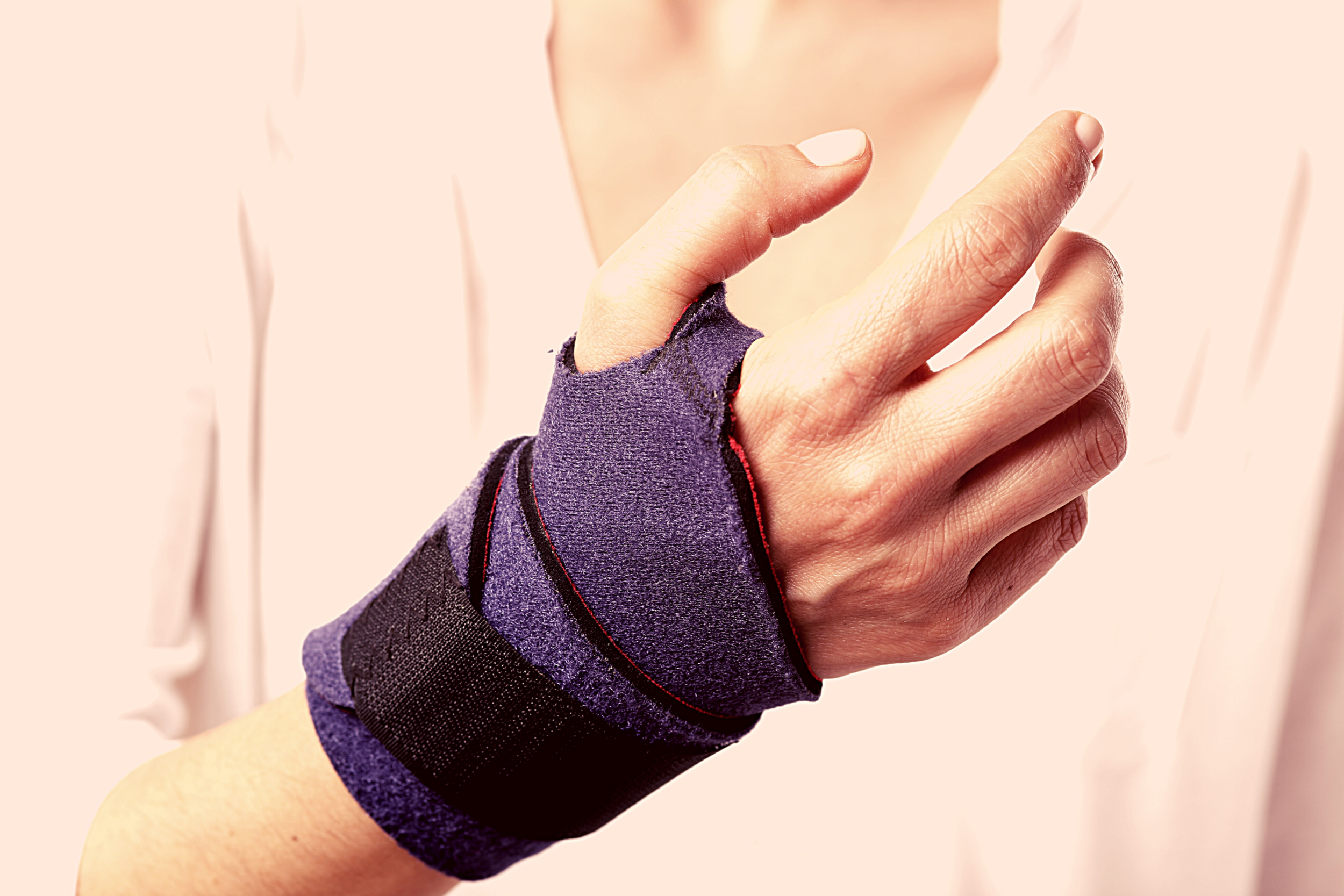
Who is at risk for developing carpal tunnel syndrome?
Several factors can increase the likelihood of developing carpal tunnel syndrome:
- Gender: Women are more prone to CTS, partly due to having smaller carpal tunnels
- Pregnancy: Hormonal changes can lead to fluid retention and swelling
- Diabetes: Can affect nerve health and increase susceptibility
- Obesity: Excess weight can put pressure on the median nerve
- Thyroid disorders: Can affect fluid balance and nerve function
- Arthritis: Particularly when it affects the wrist
- Repetitive wrist movements: Especially with vibrating tools
Contrary to popular belief, activities like keyboarding are not strongly linked to carpal tunnel syndrome. However, using heavy or vibrating equipment regularly may increase the risk.
Diagnosing Carpal Tunnel Syndrome: When to See a Doctor
If you’re experiencing persistent tingling, numbness, or pain in your hand and wrist, it’s crucial to consult a healthcare professional. Early diagnosis can prevent long-term nerve damage and improve treatment outcomes.
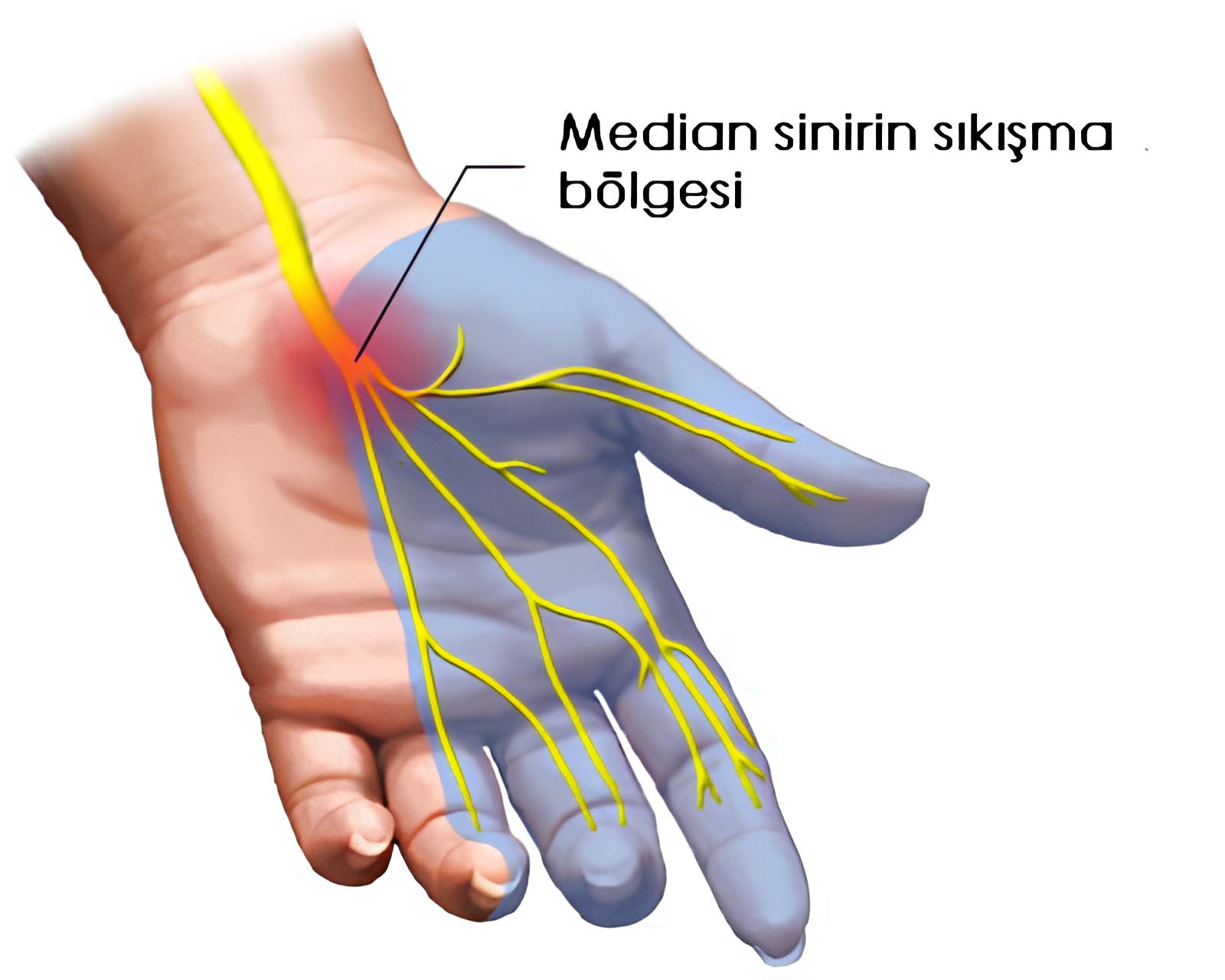
How is carpal tunnel syndrome diagnosed?
Diagnosis typically involves:
- A thorough medical history and physical examination
- Nerve conduction studies and electromyography (EMG) to assess nerve function
- Ultrasound imaging, which can provide detailed views of the carpal tunnel
These tests help differentiate carpal tunnel syndrome from other conditions with similar symptoms, such as cervical radiculopathy or peripheral neuropathy.
Treatment Options for Carpal Tunnel Syndrome: From Conservative to Surgical
The treatment approach for carpal tunnel syndrome depends on the severity of symptoms and the extent of nerve compression. Early intervention is key to preventing permanent nerve damage.
What are the conservative treatments for carpal tunnel syndrome?
For mild cases, non-surgical treatments may include:
- Wrist splinting, especially at night
- Rest and activity modification
- Non-steroidal anti-inflammatory drugs (NSAIDs) for pain relief
- Steroid injections to reduce inflammation
These conservative measures can often provide significant relief, particularly when implemented early in the course of the condition.

When is surgery necessary for carpal tunnel syndrome?
If conservative treatments fail to alleviate symptoms or if there’s evidence of severe nerve compression, surgery may be recommended. The procedure, known as carpal tunnel release, involves cutting the ligament that forms the roof of the carpal tunnel to relieve pressure on the median nerve.
Dr. Tamara Rozental, a Harvard Medical School professor and hand surgery expert, emphasizes the importance of timely surgical intervention: “The mistake that people often make is waiting too long to get surgery. If the nerve is compressed long enough, the muscle atrophies and the nerve damage becomes permanent.”
Preventing Permanent Nerve Damage: The Importance of Early Treatment
Delaying treatment for carpal tunnel syndrome can lead to irreversible nerve damage. As the condition progresses, symptoms may worsen, potentially resulting in:
- Constant numbness in the affected fingers
- Weakness and atrophy of the thumb muscles
- Difficulty performing fine motor tasks
Recognizing symptoms early and seeking prompt medical attention is crucial for preventing these long-term complications.
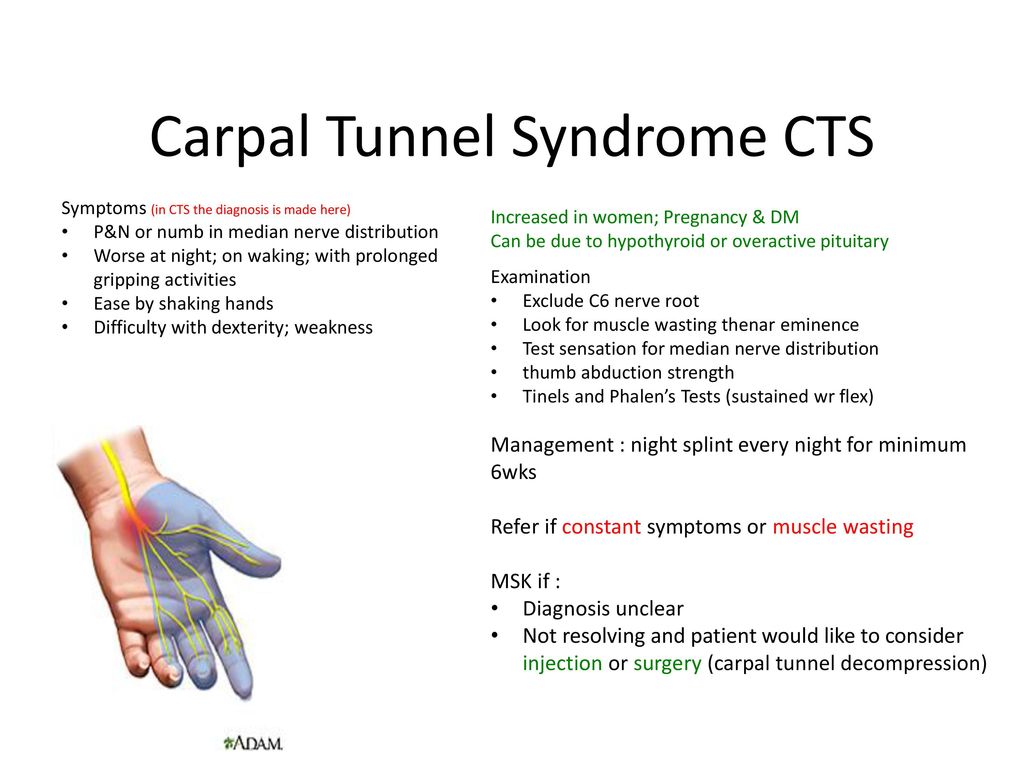
Can carpal tunnel syndrome resolve on its own?
While mild cases of carpal tunnel syndrome may improve with rest and conservative measures, it’s unusual for the condition to resolve completely without treatment. Persistent symptoms should always be evaluated by a healthcare professional to prevent progressive nerve damage.
Lifestyle Modifications and Ergonomic Adjustments for Carpal Tunnel Relief
In addition to medical treatments, certain lifestyle changes and ergonomic adjustments can help manage carpal tunnel syndrome and prevent its progression.
What ergonomic changes can help alleviate carpal tunnel symptoms?
Consider implementing the following modifications:
- Maintain proper wrist position while working or using devices
- Use ergonomic keyboards and mouse devices
- Take regular breaks to stretch and move your hands and wrists
- Adjust your workstation to promote neutral wrist positioning
These changes can help reduce stress on the median nerve and may complement other treatment approaches.

Recovery and Rehabilitation After Carpal Tunnel Treatment
Whether you’ve undergone conservative treatment or surgery for carpal tunnel syndrome, proper recovery and rehabilitation are essential for optimal outcomes.
What does recovery from carpal tunnel surgery typically involve?
Post-surgical recovery may include:
- A brief period of rest and elevation of the hand
- Gradual return to normal activities, often within a few weeks
- Hand therapy exercises to improve strength and flexibility
- Follow-up appointments to monitor healing and nerve function
Most patients experience significant improvement in symptoms following carpal tunnel release surgery, with many able to return to normal activities relatively quickly.
Long-term Outlook and Management of Carpal Tunnel Syndrome
Understanding the long-term prognosis and ongoing management of carpal tunnel syndrome is crucial for patients and healthcare providers alike.
Can carpal tunnel syndrome recur after treatment?
While recurrence of carpal tunnel syndrome after successful treatment is relatively rare, it can happen. Factors that may contribute to recurrence include:

- Incomplete release of the carpal ligament during surgery
- Formation of scar tissue around the median nerve
- Persistent or new risk factors (e.g., weight gain, development of arthritis)
Ongoing attention to ergonomics and management of underlying health conditions can help prevent recurrence.
What are the latest advancements in carpal tunnel syndrome treatment?
Research in carpal tunnel syndrome management continues to evolve, with several promising developments:
- Minimally invasive surgical techniques, reducing recovery time
- Advanced imaging methods for more precise diagnosis
- Novel therapeutic approaches, such as platelet-rich plasma injections
- Improved rehabilitation protocols to enhance post-treatment outcomes
These advancements aim to improve treatment efficacy and patient experience, potentially leading to better long-term outcomes for those affected by carpal tunnel syndrome.
The Role of Interdisciplinary Care in Managing Carpal Tunnel Syndrome
Effective management of carpal tunnel syndrome often requires a collaborative approach involving various healthcare professionals. This interdisciplinary care model ensures comprehensive treatment and optimal outcomes for patients.
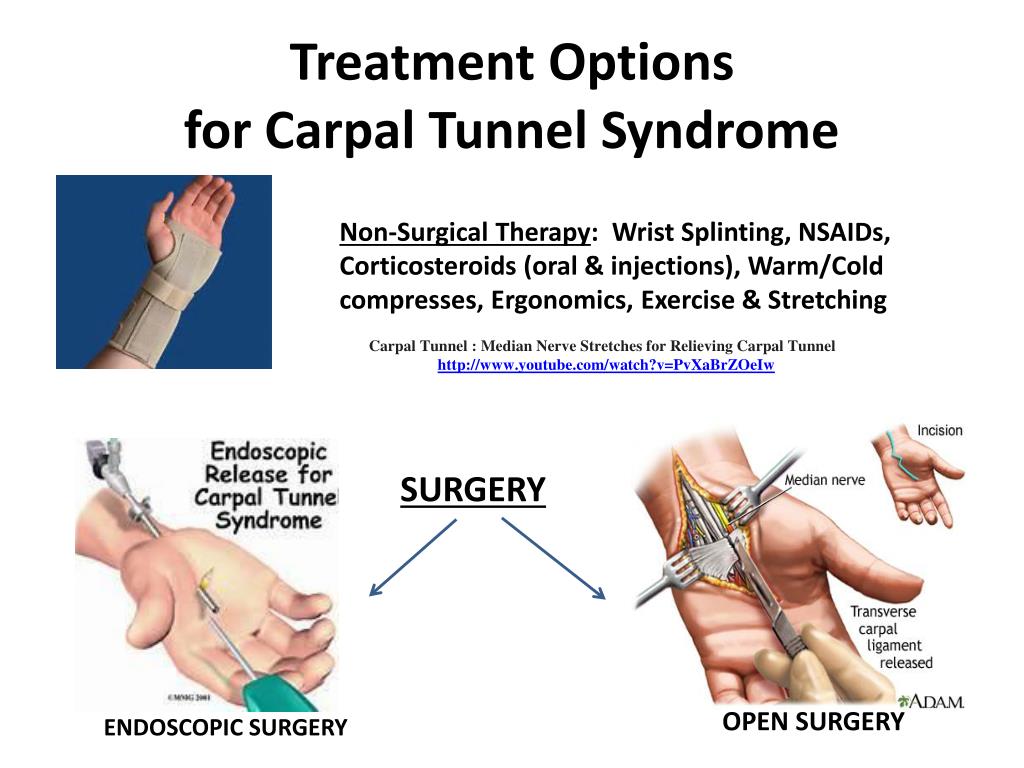
Which healthcare professionals are typically involved in carpal tunnel syndrome care?
The care team may include:
- Primary care physicians for initial evaluation and referral
- Neurologists for detailed nerve function assessment
- Orthopedic or hand surgeons for surgical intervention when necessary
- Physical or occupational therapists for rehabilitation and ergonomic guidance
- Pain management specialists for advanced non-surgical treatments
This collaborative approach allows for tailored treatment plans that address all aspects of the condition, from diagnosis to long-term management.
How can patients actively participate in their carpal tunnel syndrome care?
Patient engagement is crucial for successful management of carpal tunnel syndrome. Patients can take an active role by:
- Maintaining open communication with their healthcare team
- Adhering to prescribed treatments and exercises
- Implementing recommended ergonomic changes at work and home
- Monitoring and reporting any changes in symptoms promptly
- Managing underlying health conditions that may exacerbate CTS
By actively participating in their care, patients can significantly improve their outcomes and quality of life while managing carpal tunnel syndrome.

In conclusion, carpal tunnel syndrome is a common but manageable condition that requires prompt attention and appropriate care. By understanding the symptoms, seeking early diagnosis, and following through with recommended treatments, individuals can prevent permanent nerve damage and maintain optimal hand function. Whether through conservative measures or surgical intervention, the goal is to alleviate symptoms and improve quality of life. With ongoing advancements in treatment and a focus on interdisciplinary care, the outlook for those affected by carpal tunnel syndrome continues to improve.
Don’t delay treatment for carpal tunnel syndrome
First, you may notice tingling or numbness in your fingers that comes and goes. Over time, the sensations may get worse, lasting longer or even waking you up at night. Eventually the pain and numbness might even make it hard to grip things like a fork, a pen, or other objects.
If you’re having these symptoms, it could be carpal tunnel syndrome, which occurs when the median nerve — which runs down your arm and into your hand — is compressed by a ligament that crosses over it as it passes through a narrow space in the wrist known as the carpal tunnel.
“Carpal tunnel syndrome has classic symptoms, which include numbness and tingling in the thumb, index finger, middle finger, and half of the ring finger,” says Dr. Tamara Rozental, professor of orthopedic surgery at Harvard Medical School and chief of hand and upper extremity surgery at Beth Israel Deaconess Medical Center. Your little finger is typically not affected because a different nerve serves it.
Women at risk
Women tend to be more prone to carpal tunnel syndrome because of risk factors, such as pregnancy, that are specific to their sex. Other risk factors include:
- diabetes
- cysts that encroach on carpal tunnel passageway
- drinking alcohol
- being overweight
- thyroid disease
- arthritis affecting the wrist.
While it used to be thought that repetitive activities such as keyboarding could cause carpal tunnel syndrome, research has found that this is largely not the case, says Dr. Rozental. However, regular use of heavy or vibrating equipment, such as a jackhammer, may predispose you to the condition.
Diagnosis
Your doctor can usually diagnose carpal tunnel syndrome based on your symptoms and the findings on physical examination. But in some cases, you may need additional tests to ensure that those symptoms aren’t being caused by another condition, such as arthritis, a pinched nerve in your neck, or neuropathy (nerve disease that can be a complication of diabetes or other conditions), says Dr. Rozental.
Rozental.
One of the tests used to confirm carpal tunnel syndrome, a nerve conduction study and electromyogram (EMG), uses an electrical signal to determine how well the nerve is working. Another test uses ultrasound, which is less invasive than an EMG but requires an experienced technician and is not as widely available.
Treating carpal tunnel syndrome
For mild cases of carpal tunnel syndrome, resting your hand and wearing a splint at night might be all it takes to relieve symptoms. Symptoms of carpal tunnel syndrome often occur at night, causing people to wake up and shake or move their hand around until the numbness resolves and it feels better, says Dr. Rozental. Medications, such as aspirin and ibuprofen aren’t a cure, but can help relieve pain. Your doctor may also want to try giving you steroid injections to help relieve symptoms.
If these carpal tunnel treatments aren’t effective, however, it may be time to consider surgery to release the ligament that is placing pressure on the median nerve.
When to get surgery
“The mistake that people often make is waiting too long to get surgery,” says Dr. Rozental. “I see a lot of people who say that their numbness was gradually worsening and now their hand is completely numb and has been for a year.” If the nerve is compressed long enough, the muscle atrophies and the nerve damage becomes permanent, she says.
So, if your carpal tunnel symptoms aren’t responding to other treatments, take action quickly.
The surgery takes 10 minutes under a local anesthetic. Unless you do a job that involves manual labor, you can typically go right back to normal activities, says Dr. Rozental.
“I tell my patients all the time that a carpal tunnel release done at the right time for the correct diagnosis is very successful,” she says.
Image: © Daisy-Daisy/Getty Images
Carpal Tunnel Syndrome – StatPearls
Continuing Education Activity
Carpal tunnel syndrome (CTS) is an entrapment neuropathy caused by compression of the median nerve as it travels through the wrist’s carpal tunnel. It is the most common nerve entrapment neuropathy, accounting for 90% of all neuropathies. Early symptoms of carpal tunnel syndrome include pain, numbness, and paresthesias. This activity reviews the etiology, presentation, evaluation, and management of carpal tunnel syndrome, and highlights the role of the interprofessional team in evaluating, and managing the condition.
It is the most common nerve entrapment neuropathy, accounting for 90% of all neuropathies. Early symptoms of carpal tunnel syndrome include pain, numbness, and paresthesias. This activity reviews the etiology, presentation, evaluation, and management of carpal tunnel syndrome, and highlights the role of the interprofessional team in evaluating, and managing the condition.
Objectives:
Describe the pathophysiology of carpal tunnel syndrome, including triggering and exacerbating factors and activities.
Review the necessary elements for an examination to assess for carpal tunnel syndrome, including any necessary diagnostic imaging studies.
Summarize the treatment options available for carpal tunnel syndrome, including both conservative and surgical care.
Explain possible interprofessional team strategies for improving care coordination and communication to advance the evaluation and treatment of carpal tunnel syndrome and improve outcomes.

Access free multiple choice questions on this topic.
Introduction
Carpal tunnel syndrome (CTS) is an entrapment neuropathy caused by compression of the median nerve as it travels through the wrist’s carpal tunnel. It is the most common nerve entrapment neuropathy, accounting for 90% of all neuropathies. Early symptoms of carpal tunnel syndrome include pain, numbness, and paresthesias. These symptoms typically present, with some variability, in the thumb, index finger, middle finger, and the radial half (thumb side) of the ring finger. Pain also can radiate up the affected arm. With further progression, hand weakness, decreased fine motor coordination, clumsiness, and thenar atrophy can occur.
In the early presentation of the disease, symptoms most often present at night when lying down and are relieved during the day. With further progression of the disease, symptoms will also be present during the day, especially with certain repetitive activities, such as when drawing, typing, or playing video games. In more advanced disease, symptoms can be constant.
In more advanced disease, symptoms can be constant.
Typical occupations of patients with carpal tunnel syndrome include those who use computers for extended periods of time, those who use equipment that has vibration such as construction workers, and any other occupation requiring frequent, repetitive movement.[1][2][3]
Etiology
Carpal tunnel syndrome results from increased carpal tunnel pressure and subsequent compression of the median nerve. The most common causes of carpal tunnel syndrome include genetic predisposition, history of repetitive wrist movements such as typing, or machine work as well as obesity, autoimmune disorders such as rheumatoid arthritis, and pregnancy.[4]
The majority of CTS cases are idiopathic. Secondary CTS causes are divided into abnormalities of the container or content. Dynamic CTS can occur with manual work.
Secondary Carpal Tunnel Syndrome
- Abnormalities of the Container – Any condition that modifies the walls of the carpal tunnel may cause compression of the median nerve
Dislocation or subluxation of the carpus
Fractures or skewed consolidation of the distal radius
Wrist arthrosis, inflammatory arthritis, infectious arthritis
Acromegaly
- Abnormalities of Content
Tenosynovial hypertrophy
Inflammatory rheumatism, and infection
Diabetes mellitus (abnormality of collagen turnover), primary or secondary amyloidosis (chronic hemodialysis with deposition of beta-2-microglobulin), and go
Abnormalities of fluid distribution: pregnancy, hypothyroidism, and chronic kidney failure (arteriovenous fistula)
Arterial hypertrophy of the median nerve
Intratunnel tumor: lipoma, synovial cyst, synovial sarcoma, or neural tumor (schwannoma, neurofibroma, or lipofibroma)
Hematoma due to hemophilia, anticoagulant accident or trauma
Obesity
Dynamic Carpal Tunnel Syndrome – The pressure inside the carpal tunnel increases during the wrist’s repetitive extension and flexion movements.
 This particular movement can be seen in occupational pathological conditions.
This particular movement can be seen in occupational pathological conditions.Exposure to Vibration – Exposure to vibration causes ultrastructural consequences that comprise microcirculatory compression problems and intraneural edema following an injury of the myelin and axons.
Epidemiology
Frequency
In the United States, carpal tunnel syndrome (CTS) has an incidence of 1 to 3 persons per 1000 per year, with a prevalence of 50 per 1000, with similar incidence and prevalence in most developed countries.
Race
It most commonly affects Whites. Whites are two to three times more prone to get affected than Blacks.
Age
The peak age of CTS occurrence is 40-60 years.
Gender
CTS is ten times more common in females as compared to males.[5]
Mortality/Morbidity
Carpal tunnel syndrome does not cause mortality, but it can lead to irreversible median nerve damage, with severe loss of hand function, if not treated.
Pathophysiology
Carpal tunnel syndrome (CTS) is multifactorial and often results from multiple patient-specific, occupational, social, and environmental risk factors. A single, specific cause is not always determined unless there is, for example, a space-occupying lesion that can be attributable to patient-reported symptoms. While this can be appreciated in select medical conditions (e.g., gout), these relatively straightforward clinical presentations are relatively uncommon in comparison to most presentations of CTS.
In general, the pathophysiology of CTS results from a combination of compression and traction mechanisms. The compressive element of the pathophysiology includes a detrimental cycle of increased pressure, obstruction of overall venous outflow, increasing local edema, and compromise to the median nerve’s intraneural microcirculation. Nerve dysfunction becomes compromised, and the structural integrity of the nerve itself further propagates the dysfunctional environment – the myelin sheath and axon develop lesions, and the surrounding connective tissues become inflamed and lose normal physiologic protective and supportive function. Repetitive traction and wrist motion exacerbate the negative environment, further injuring the nerve. In addition, any of the nine flexor tendons traveling through the carpal tunnel can become inflamed and compress the median nerve.[6] Sensory fibers often are affected before motor fibers. Autonomic nerve fibers carried in the median nerve also may be affected.
Repetitive traction and wrist motion exacerbate the negative environment, further injuring the nerve. In addition, any of the nine flexor tendons traveling through the carpal tunnel can become inflamed and compress the median nerve.[6] Sensory fibers often are affected before motor fibers. Autonomic nerve fibers carried in the median nerve also may be affected.
History and Physical
History
Patients often report numbness, tingling, and pain that increase at night. Weakness, clumsiness, and temperature changes also are common complaints. The thumb, second and third digits, and the radial half of the fourth digit are typically affected. Symptoms are intermittent and are associated with activities like driving, reading the newspaper, and painting. Nighttime symptoms are more specific to CTS, especially if the patient relieves symptoms by shaking the hand/wrist. Bilateral CTS is common, but the dominant hand is usually affected first. Numbness predominantly in the fifth digit or extending to the thenar eminence or dorsum of the hand should suggest other diagnoses.
Physical
The clinical physical exam may include testing for sensory and motor deficits and evidence of thenar wasting. There are several special tests with varying degrees of sensitivities and specificities.
Sensory Examination
Abnormalities in sensory modalities are usually present on the palmar aspect of the first three digits and radial one-half of the fourth digit. Sensory examination is most useful in confirming that thenar eminence, hypothenar eminence, and the dorsum of the first web space are normal.
Motor Examination
Wasting and weakness of first and second lumbricals, opponens pollicis, abductor pollicis brevis, and flexor pollicis brevis.
Special Tests
Hoffmann-Tinel sign – Although a low sensitivity and specificity, the Hoffmann-Tinel sign is another test commonly performed. In this test the healthcare professional taps immediately over the carpal tunnel to stimulate the median nerve.
 Like the above tests, a positive test is when symptoms are reproduced.
Like the above tests, a positive test is when symptoms are reproduced.The carpal compression test – The carpal compression test is the best test. This is done by applying firm pressure directly over the carpal tunnel for 30 seconds. The test is positive when paresthesias, pain, or other symptoms are reproduced.
Phalen sign – The Phalen test or ‘reverse prayer’ is performed by having the patient fully flex their wrists by placing dorsal surfaces of both hands for one minute. A positive test is when symptoms (numbness, tingling, pain) are reproduced.
Reverse Phalen test – The reverse Phalen, or ‘prayer test,’ is done by having the patient extend both of their wrists by placing palmar surfaces of both hands together for one minute (as if praying). Again a positive test is with the reproduction of symptoms.
Palpatory diagnosis – Another test is a palpatory diagnosis. In this test, the health care provider examines soft tissue over the median nerve for mechanical restriction.

The square wrist sign – The square sign test is an evaluation to determine the risk of developing carpal tunnel syndrome. The test is positive if the ratio of the thickness of the wrist divided by the width of the wrist is great than 0.7.
Evaluation
There is no blood test that could help in the diagnosis of carpal tunnel syndrome.
Magnetic Resonance Imaging (MRI)
MRI of the carpal tunnel is particularly useful preoperatively if a space-occupying lesion in the carpal tunnel is suggested. MRI is a resource-intensive investigation and does not rule out other differential diagnoses.
Ultrasonography
Ultrasonography potentially can identify space-occupying lesions in the carpal tunnel. It can also detect abnormalities in the median nerve like an increased cross-sectional area that can be diagnostic of CTS. Ultrasonography can also help to guide steroid injections into the carpal tunnel.[7]
Electromyography and Nerve Conduction Studies
Electromyography and nerve conduction studies are the basis for carpal tunnel syndrome diagnosis. Other clinical or special exams do not confirm carpal tunnel syndrome but do assist in ruling out other diagnoses. These findings can prompt electromyography and nerve conduction studies. Abnormalities on electrophysiologic testing, in association with specific symptoms and signs, are considered the gold standard for CTS diagnosis. Electrophysiologic testing also can assess the severity of the damage to the nerve and also determine prognosis. CTS is usually divided into mild, moderate, and severe. In mild CTS patients have sensory abnormalities alone on electrophysiologic testing, and in moderate CTS patients have sensory plus motor abnormalities.
Other clinical or special exams do not confirm carpal tunnel syndrome but do assist in ruling out other diagnoses. These findings can prompt electromyography and nerve conduction studies. Abnormalities on electrophysiologic testing, in association with specific symptoms and signs, are considered the gold standard for CTS diagnosis. Electrophysiologic testing also can assess the severity of the damage to the nerve and also determine prognosis. CTS is usually divided into mild, moderate, and severe. In mild CTS patients have sensory abnormalities alone on electrophysiologic testing, and in moderate CTS patients have sensory plus motor abnormalities.
Treatment / Management
If carpal tunnel syndrome is identified early, conservative treatment is recommended.
Physical and Occupational Therapy
Initially, the patient should be instructed in modifying symptom provoking wrist movement. This can be through proper hand ergonomics such as placing the keyboard at a proper height and minimizing flexion, extension, abduction, and adduction of the hand when typing. It should be recommended to decrease repetitive activities if possible. Counseling on weight loss and increased aerobic activity also can be beneficial. A properly fitted nighttime wrist splint can be offered. An occupational therapist trained in hand therapy also may be a beneficial referral. Combined therapy may be more beneficial than any single treatment. A short course of nonsteroidal anti-inflammatory medication can relieve symptoms but some do not feel it of adequate benefit.
It should be recommended to decrease repetitive activities if possible. Counseling on weight loss and increased aerobic activity also can be beneficial. A properly fitted nighttime wrist splint can be offered. An occupational therapist trained in hand therapy also may be a beneficial referral. Combined therapy may be more beneficial than any single treatment. A short course of nonsteroidal anti-inflammatory medication can relieve symptoms but some do not feel it of adequate benefit.
Medical Treatment
Patients with mild to moderate carpal tunnel syndrome respond to conservative management, which includes splinting the wrist at nighttime for at least three weeks. If conservative treatment fails, a steroid injection into the carpal tunnel can be beneficial.[8] Steroid injections may also be beneficial before surgical management or when surgery is relatively contraindicated as in pregnancy.[8] Median nerve measurements by ultrasound can predict response to steroid injection.
Nonsteroidal anti-inflammatory drugs (NSAIDs) may be useful against CTS in patients with wrist flexor tendinitis. Similarly, diuretics can be helpful in patients with fluid overload. gabapentin and pregabalin, which are used in different types of neuropathic pain, can be used, for CTS off-label.[9] The American Academy of Orthopaedic Surgeons state that oral agents are no better than placebo in the treatment of CTS.
Surgical Treatment
Patients who do not get better following conservative treatment and those who have severe carpal tunnel syndrome as defined by electrophysiologic testing should be considered for surgery. The definitive treatment for persistent carpal tunnel syndrome is a surgical intervention with carpal tunnel release after nerve conduction studies showing significant axonal degeneration. Carpal tunnel release typically is performed by a neuro/orthopedic/plastic surgeon or hand surgeon. This procedure can be performed either open or endoscopically. Carpal tunnel release is considered a minor surgery in which the transverse carpal ligament or flexor retinaculum is cut, opening more space in the carpal tunnel and decreasing pressure on the median nerve. It does not typically require overnight hospitalization.[10][11][12] Surgical release of the transverse ligament gives greater than 90% initial success rate, and low rates of complication. However, it has been found in different trials that the long-term success rate is lower than initially thought (approximately 60% at 5 years).
Carpal tunnel release is considered a minor surgery in which the transverse carpal ligament or flexor retinaculum is cut, opening more space in the carpal tunnel and decreasing pressure on the median nerve. It does not typically require overnight hospitalization.[10][11][12] Surgical release of the transverse ligament gives greater than 90% initial success rate, and low rates of complication. However, it has been found in different trials that the long-term success rate is lower than initially thought (approximately 60% at 5 years).
Guidelines by the American Academy of Orthopaedic Surgeons
The American Academy of Orthopaedic Surgeons released guidelines on the management of CTS. Following recommendations were made:
Thenar atrophy is strongly associated with ruling in CTS but is poorly associated with ruling it out
Phalen test, Tinel sign, flick sign, or upper limb neurodynamic/nerve tension test (ULNT) criterion A/B should not be used as independent physical examination maneuvers to diagnose CTS, because alone, each has a poor or weak association with ruling in or ruling out the condition
Independent history interview topics should not be used to diagnose CTS, because alone, each has a poor or weak association with ruling in or ruling out the condition: sex/gender, ethnicity, bilateral symptoms, diabetes mellitus, worsening symptoms at night, duration of symptoms, patient localization of symptoms, hand dominance, symptomatic limb, age, and body mass index
Magnetic resonance imaging (MRI) should not be a routine for the diagnosis of CTS
Diagnostic questionnaires and/or electrodiagnostic studies can be used to aid the diagnosis of CTS
The following factors are associated with an increased risk of developing CTS: peri-menopausal, wrist ratio/index, rheumatoid arthritis, psychosocial factors, distal upper extremity tendinopathies, gardening, assembly line work, computer work, vibration, tendonitis, workplace forceful grip/exertion
Physical activity/exercise is associated with a decreased risk of developing CTS
The use of immobilization (brace/splint/orthosis) should improve patient-reported outcomes
The use of steroid (methylprednisolone) injection should improve patient-reported outcomes
There is no benefit to oral CTS treatments (diuretic, gabapentin, astaxanthin capsules, nonsteroidal anti-inflammatory drugs [NSAIDs], or pyridoxine) over placebo
Oral steroids could improve patient-reported outcomes in comparison with placebo
The surgical release of the transverse carpal ligament should relieve CTS symptoms and improve function
Surgical treatment of CTS should have a greater therapeutic benefit at 6 and 12 months in comparison with splinting, NSAIDs/therapy, and a single steroid injection
There is no benefit to routine postoperative immobilization after carpal tunnel release
Differential Diagnosis
The presentation of carpal tunnel syndrome mimics many other disorders of the musculoskeletal and nervous systems. Following differentials should be considered while assessing a patient with carpal tunnel syndrome:
Following differentials should be considered while assessing a patient with carpal tunnel syndrome:
Cervical disc disease
Cervical myofascial pain
Cervical spondylosis
Mononeuritis multiplex
Multiple sclerosis
Diabetic neuropathy
Cervical radiculopathy
Overuse injury
Traumatic brachial plexopathy
Radiation-induced brachial plexopathy
Neuropathies
Tendonitis
Tenosynovitis
Thoracic outlet syndrome
Prognosis
Carpal tunnel syndrome (CTS) is usually progressive over time and can cause permanent median nerve damage. The syndrome recurs to some degree even after surgical management in up to one-third of the patients after 5 years. Almost 90% of mild to moderate CTS cases respond to conservative management. However, many patients progress to requiring surgery. Patients with CTS secondary to diabetes or wrist fracture tend to have a less favorable prognosis than do those with no apparent underlying cause. Patients who have normal electrophysiologic studies have much less favorable operative outcomes than do individuals with abnormalities on these tests and also more complications. Axonal loss on electrophysiologic testing is also a poor prognostic factor.
Patients who have normal electrophysiologic studies have much less favorable operative outcomes than do individuals with abnormalities on these tests and also more complications. Axonal loss on electrophysiologic testing is also a poor prognostic factor.
Complications
Complications of carpal tunnel syndrome are divided into two groups:
Complications due to Carpal Tunnel Syndrome
Carpal tunnel syndrome may cause irreversible median nerve damage, leading to permanent impairment and disability.
Chronic wrist and hand pain with or without reflex sympathetic dystrophy.
CTS can cause atrophy and weakness of the muscles at the base of the thumb in the palm of the hand. This can lead to a lack of dexterity of the affected fingers.
Complications due to Carpal Tunnel Surgery
The most frequent complication is neuroma of the palmar cutaneous branch of the median nerve.
Hypertrophic scars
Dysesthesias after multiple procedures to release the carpal tunnel
Wrist Joint stiffness
Failure to relieve symptoms
Deterrence and Patient Education
Patients suffering from carpal tunnel syndrome should be educated about the nature of the disease, precautions that they need to take, and rehabilitative activities. These include:
These include:
Avoid repetitive hand motions, holding onto vibrating tools, heavy grasping and positioning, or working with your wrist bent down and out.
Quit smoking
Lose weight if overweight
Reduce caffeine intake
A wrist brace will sometimes decrease the symptoms. A brace keeps the wrist in a resting position, not bent back or bent down too far. A brace can be especially helpful for relieving the numbness and pain felt at night because it can keep your hand from curling under as you sleep. The wrist brace can also be worn during the day.
Consult with a physical or occupational therapist. Therapist may check the workstation and the way the patient does his/her work tasks. Therapist would give suggestions regarding the use of healthy body alignment and wrist positions, helpful exercises, and tips on how to prevent future problems.
Pearls and Other Issues
The carpal tunnel includes the median nerve and nine flexor tendons. The flexor tendons include the four tendons from the flexor digitorum profundus, four tendons from the flexor digitorum superficialis, and one tendon from the flexor pollicis longus. The transverse carpal ligament (flexor retinaculum) makes up the superior boundary, and the carpal bones form the inferior border.
The flexor tendons include the four tendons from the flexor digitorum profundus, four tendons from the flexor digitorum superficialis, and one tendon from the flexor pollicis longus. The transverse carpal ligament (flexor retinaculum) makes up the superior boundary, and the carpal bones form the inferior border.
Enhancing Healthcare Team Outcomes
The diagnosis and management of carpal tunnel syndrome are done with an interprofessional team that includes the primary care provider, nurse practitioner, physical therapist, neuro/orthopedic/plastic surgeon, and the emergency department provider. The initial treatment is usually conservative combined with limiting repetitive activities. A properly fitted nighttime wrist splint can be offered. An occupational therapist trained in hand therapy also may be a beneficial referral. Combined therapy may be more beneficial than any single treatment. A short course of nonsteroidal anti-inflammatory medication can relieve symptoms but some do not feel it is of adequate benefit.
Many other treatments are available to treat carpal tunnel syndrome including surgery. An orthopedic specialty nurse can assist at all phases of care, regardless of whether treatment is conservative or surgical. While surgery can relieve symptoms, recurrence is not uncommon. The patient must be fully educated about the potential complications of surgery which should only be undertaken after conservative treatments have failed. An interprofessional team approach will lead to better outcomes for patients with CTS.[13][14] [Level 5]
Review Questions
Access free multiple choice questions on this topic.
Comment on this article.
Figure
Untreated Carpal Tunnel Syndrome. Contributed by Wikimedia Commons, Dr. Harry Gouvas, MD, PhD (Public Domain)
Figure
Carpal tunnel syndrome. Image courtesy S Bhimji MD
Figure
Physical exam maneuvers that test for carpal tunnel syndrome. Contributed by Rian Kabir, MD
References
- 1.

Mezian K, Bruthans J. Why do local corticosteroid injections work in carpal tunnel syndrome, But not in ulnar neuropathy at the elbow? Muscle Nerve. 2016 Aug;54(2):344. [PubMed: 27144462]
- 2.
Maher AB. Neurological assessment. Int J Orthop Trauma Nurs. 2016 Aug;22:44-53. [PubMed: 27118633]
- 3.
Akhondi H, Varacallo M. StatPearls [Internet]. StatPearls Publishing; Treasure Island (FL): Sep 4, 2022. Anterior Interosseous Syndrome. [PubMed: 30247831]
- 4.
Sevy JO, Varacallo M. StatPearls [Internet]. StatPearls Publishing; Treasure Island (FL): Sep 5, 2022. Carpal Tunnel Syndrome. [PubMed: 28846321]
- 5.
Hegmann KT, Merryweather A, Thiese MS, Kendall R, Garg A, Kapellusch J, Foster J, Drury D, Wood EM, Melhorn JM. Median Nerve Symptoms, Signs, and Electrodiagnostic Abnormalities Among Working Adults. J Am Acad Orthop Surg. 2018 Aug 15;26(16):576-584. [PubMed: 30028751]
- 6.
Pester JM, Bechmann S, Varacallo M.
 StatPearls [Internet]. StatPearls Publishing; Treasure Island (FL): Sep 4, 2022. Median Nerve Block Techniques. [PubMed: 29083641]
StatPearls [Internet]. StatPearls Publishing; Treasure Island (FL): Sep 4, 2022. Median Nerve Block Techniques. [PubMed: 29083641]- 7.
Tai TW, Wu CY, Su FC, Chern TC, Jou IM. Ultrasonography for diagnosing carpal tunnel syndrome: a meta-analysis of diagnostic test accuracy. Ultrasound Med Biol. 2012 Jul;38(7):1121-8. [PubMed: 22542258]
- 8.
Marshall S, Tardif G, Ashworth N. Local corticosteroid injection for carpal tunnel syndrome. Cochrane Database Syst Rev. 2007 Apr 18;(2):CD001554. [PubMed: 17443508]
- 9.
Eftekharsadat B, Babaei-Ghazani A, Habibzadeh A. The Efficacy of 100 and 300 mg Gabapentin in the Treatment of Carpal Tunnel Syndrome. Iran J Pharm Res. 2015 Fall;14(4):1275-80. [PMC free article: PMC4673958] [PubMed: 26664397]
- 10.
Sears ED, Swiatek PR, Hou H, Chung KC. Utilization of Preoperative Electrodiagnostic Studies for Carpal Tunnel Syndrome: An Analysis of National Practice Patterns. J Hand Surg Am.
 2016 Jun;41(6):665-672.e1. [PMC free article: PMC4899197] [PubMed: 27068003]
2016 Jun;41(6):665-672.e1. [PMC free article: PMC4899197] [PubMed: 27068003]- 11.
Mooar PA, Doherty WJ, Murray JN, Pezold R, Sevarino KS. Management of Carpal Tunnel Syndrome. J Am Acad Orthop Surg. 2018 Mar 15;26(6):e128-e130. [PubMed: 29420323]
- 12.
Raizman NM, Blazar PE. AAOS Appropriate Use Criteria: Management of Carpal Tunnel Syndrome. J Am Acad Orthop Surg. 2018 Mar 15;26(6):e131-e133. [PubMed: 29432365]
- 13.
Carmona A, Hidalgo Diaz JJ, Facca S, Igeta Y, Pizza C, Liverneaux P. Revision surgery in carpal tunnel syndrome: a retrospective study comparing the Canaletto® device alone versus a combination of Canaletto® and Dynavisc® gel. Hand Surg Rehabil. 2019 Feb;38(1):52-58. [PubMed: 30472072]
- 14.
Eroğlu A, Sarı E, Topuz AK, Şimşek H, Pusat S. Recurrent carpal tunnel syndrome: Evaluation and treatment of the possible causes. World J Clin Cases. 2018 Sep 26;6(10):365-372. [PMC free article: PMC6163139] [PubMed: 30283799]
Disclosure: Justin Sevy declares no relevant financial relationships with ineligible companies.

Disclosure: Matthew Varacallo declares no relevant financial relationships with ineligible companies.
Carpal tunnel syndrome (carpal tunnel syndrome): causes, symptoms and recommendations for the treatment of the disease. Dr. Peter
More than 150 years have passed since the first description of severe disorders of trophism and function of the hand with a fracture of the radius in a typical place (Paget, 1870), however, the question of the causes of carpal tunnel stenosis is still being discussed. Unlike other localizations of stenosis of the tendon canals of the hand, in the carpal tunnel, not only the flexor tendons of all fingers are subjected to compression, but also the median nerve, which quickly suffers from ischemia.
In this regard, neurological disorders come to the fore and there are various names for this pathology: chronic compression of the median nerve, compression neuralgia of the median nerve. The term “carpal tunnel syndrome” was introduced by Kremmer et al. in 1953 and has been widely used as the most reasonable. In the literature, there are also descriptions of rare cases of compression of the median nerve, for example, an abnormal branch of the motor branch of the median nerve (Mac Kjnnon et al., 1988g.)
in 1953 and has been widely used as the most reasonable. In the literature, there are also descriptions of rare cases of compression of the median nerve, for example, an abnormal branch of the motor branch of the median nerve (Mac Kjnnon et al., 1988g.)
In case of carpal tunnel syndrome, a narrowing of an important part of the tendon, the so-called carpal tunnel, occurs in the area of the wrist. It compresses the nerve that innervates certain areas of the hand. Possible consequences are discomfort, pain, and signs of paralysis.
The carpal tunnel is formed by the bones of the wrist and the support of the flexor tendons of the fingers. Some tendons of the hand and the median nerve of the hand (medial nerve) run in its center. It runs from the shoulder along the upper and lower arms. In addition to the other two nerves, it controls muscle movements and provides the sense of touch. In carpal tunnel syndrome, the median nerve is put under pressure and can be permanently damaged.
If the carpal tunnel narrows, the nerve is compressed and the innervation of the muscles and skin of the hand innervated by the median nerve is disturbed.
Then the typical symptoms of carpal tunnel syndrome appear, such as numbness, pain, and later even signs of paralysis.
Causes
There are a number of possible triggers for carpal tunnel syndrome and various risk factors that make it more likely.
People who naturally have a fairly narrow carpal tunnel get sick more often. For this reason, women tend to be more susceptible to carpal tunnel syndrome than men.
Heredity: Congenital anatomic narrowing is likely the reason that carpal tunnel syndrome is especially common in some families.
Sprained wrist: people who do manual labor are more susceptible to this disease than those who work in an office. People who work with machines with strong vibrations (such as jackhammers) and those whose wrists are constantly subjected to high stress, such as upholsterers or farmers, are at particularly high risk.

Injuries: Carpal tunnel syndrome develops easily after an injury near the wrist, especially after a fracture of the radius, navicular and trapezoid bones of the hand.
Inflammation: Another possible cause is inflammation and swelling of the tendon sheaths, which also lie in the carpal tunnel and then put pressure on the median nerve.
Rheumatism: Inflammation of the joints mainly affects patients with rheumatism. Thus, every second patient with rheumatism develops carpal tunnel syndrome. Often this is the first sign of an incipient rheumatic disease.
Chronic renal failure: People who have to undergo frequent dialysis due to kidney weakness develop carpal tunnel syndrome easily in the arm connected to the dialysis machine (bypass arm).
Water retention: if more water accumulates in the joints, the ligaments thicken. This reduces the space in the carpal tunnel. There are various triggers for this, such as an overactive or underactive thyroid gland, diabetes mellitus, obesity, or hormonal changes caused by pregnancy or menopause.

Symptoms of carpal tunnel syndrome
In the early stages, patients often do not take carpal tunnel syndrome seriously. However, the longer a nerve in the wrist is pinched, the more likely it is to be permanently damaged.
Early symptoms . A typical early sign of carpal tunnel syndrome is numbness in the fingers at night. In the beginning, it is usually enough to move the hand. Later, there is very severe pain that radiates to the arm and shoulder. Patients often wake up at night with pain in the fingers. Doctors also call this phenomenon paresthetic nocturnal brachialgia. Fingers swollen and stiff in the morning.
Carpal tunnel syndrome is usually indicated by unusual tingling sensations in the palms of the hands. Later, they gradually spread to part of the fingers. The median nerve of the hand innervates the inner surface of the thumb, index and middle fingers, as well as one side of the ring finger. Classical symptoms develop in this zone. The ulna of the fourth finger and the fifth finger are not affected by carpal tunnel syndrome because they are innervated by the ulnar nerve.
The ulna of the fourth finger and the fifth finger are not affected by carpal tunnel syndrome because they are innervated by the ulnar nerve.
At first, pain occurs only after a certain tension of the wrist. This includes, for example, gardening, repairs or cleaning. At a later stage, the symptoms also appear suddenly without any reason, i.e. spontaneously. The tactile and sensory sensations of the fingers are also impaired. Victims gradually experience difficulty, for example, fastening a piece of clothing or lifting small objects.
Late symptoms . Loss of sensation: If pressure is maintained on the nerves for a long time, they will become increasingly damaged. Soon, the discomfort in the fingers will disappear. In turn, they become largely insensitive. Later comes paralysis. The muscle of the thumb, which is controlled by this nerve, gradually atrophies. A visible dent forms on the ball of the thumb (thumb pad atrophy).
Atrophy of the muscles of the thumb severely limits its function. If the thumb can no longer move, it is difficult for the patient, for example, to pick up something or grab a bottle.
If the thumb can no longer move, it is difficult for the patient, for example, to pick up something or grab a bottle.
At this stage, the nerve is already severely damaged. If therapy is started only now, it is often too late – nerve damage can no longer be reversed. Possible consequences are lifelong palm numbness and thumb paralysis.
Possible complications and risks
Symptoms usually develop on both hands. However, sometimes months or even years pass between them. Since the dominant hand is more loaded, carpal tunnel syndrome usually occurs on it first, i.e. on the right hand of right-handers. Symptoms here are usually more pronounced than on the other hand.
Diagnosis
The first step in diagnosing carpal tunnel syndrome is to take a medical history. The doctor asks the patient about symptoms and possible risk factors such as physical work, previous illnesses, and family history. The next step is a physical examination. The doctor checks the following aspects:
Muscles of the ball of the thumb: he can determine by touch whether the muscle has already atrophied.

Thumb function is also examined. For example, the doctor asks the patient to hold the bottle. Carpal tunnel syndrome is characterized by the fact that the patient can no longer abduct the first finger of the hand well or at all.
Sensitivity: the doctor checks the level of sensitivity by stroking the patient’s palm with a cotton swab. If he does not perceive touch, superficial sensitivity is impaired. To test the sense of touch, the patient is given the task of picking up coins or paper clips.
Hoffmann-Tinel test: This test for carpal tunnel syndrome involves tapping the skin over the carpal tunnel. If this causes pain and discomfort to the patient, it is a symptom of the syndrome.
Phalena hand flexion test (1966): passive maximum hand flexion and fixation in this position for 1 min. leads to the occurrence of paresthesia of I–II–III fingers.
Raised hand test: raising both hands, the patient holds them for 1 min, with a positive test, paresthesia of the fingers on the hand occurs.

Local compression test: when pressing a finger on the carpal tunnel for 1 min, paresthesia of fingers I-IV along the palmar surface occurs.
However, carpal tunnel syndrome can only be accurately diagnosed on the basis of a neurological examination. To rule out other diseases with similar symptoms, the doctor often also examines the elbow area, as well as the neck and shoulders. It is also possible that the median nerve of the hand is narrowed at these points.
Using electroneurography, the doctor measures how quickly the median nerve of the hand transmits the received stimuli and transmits them to the muscle. In so-called surface ENG, electrodes are glued to the skin. Then the speed of the median nerve of the hand is compared with the speed of a healthy nerve. In addition, imaging techniques provide information about the condition of the carpal tunnel and possible causes of problems.
Ultrasound (sonography): Ultrasound can be used to determine how narrow the carpal tunnel is.
X-ray of the hand: X-ray examination assesses the width of the joint space of the wrist joint, the presence or absence of bone-traumatic and bone-destructive changes in the bones forming the wrist joint.
Magnetic resonance imaging (MRI) allows you to determine the condition of the tendons, median nerve and capsular-ligamentous apparatus of the wrist joint.
How to treat carpal tunnel syndrome
Mild cases of carpal tunnel syndrome can be treated without surgery. For example, by immobilizing the affected arm with an orthosis, a plaster splint, or a caste bandage. If the cause of the narrowing of the carpal tunnel is inflammation, it is recommended to take non-steroidal anti-inflammatory drugs, B vitamins, drugs that improve microcirculation. With low efficiency of anti-inflammatory therapy for 3-5 days, local injection therapy with diprospan is indicated. Some patients take painkillers. In some cases, carpal tunnel syndrome requires surgery.
With timely and successful surgical intervention, which usually consists of incision supported by the flexor tendons of the fingers, it is possible to completely cure carpal tunnel syndrome. If the cause of the tunnel syndrome is an improperly fused fracture of the radius or carpal bones, an operation is performed to eliminate the bone-traumatic changes.
If the cause of the tunnel syndrome is an improperly fused fracture of the radius or carpal bones, an operation is performed to eliminate the bone-traumatic changes.
Pain usually disappears the next day after the procedure. After surgical treatment, the hand is also mobilized for 2-3 weeks. In the postoperative period, physiotherapy is carried out (magnetotherapy, magneto-laser therapy). Therapeutic exercise on the fingers is performed in the early postoperative period. After the termination of immobilization, it is also performed on the wrist joint.
The immediate results of treatment are evaluated repeatedly, in dynamics, within 2 months. If pain, paresthesia disappeared and the range of motion of the hand and fingers was restored, then the result of the operation is assessed as positive.
In order to avoid the complicated course of any hand diseases, including carpal tunnel syndrome, we recommend that you contact an orthopedic traumatologist if you experience pain or sensitivity disorders in the hand.
Carpal Tunnel Syndrome – KinesioPro
Carpal tunnel syndrome (CTS) or carpal tunnel syndrome is a compression neuropathy caused by compression of the median nerve at its passage through the carpal tunnel.
- This is the most common compressive neuropathy, accounting for 90% of all neuropathies.
- Early symptoms of CTS include pain, numbness, and paresthesias.
- Symptoms may present with some variability in the thumb, index, middle fingers and the radial half (thumb side) of the ring finger.
- The pain may also radiate up the affected arm. With further progression of the disease, weakness of the hand, impaired fine motor skills, awkwardness and atrophy of the thenar muscles can be observed.
Diagnosis is easy and patients may respond well to treatment, but the best way to integrate clinical, functional and anatomical information to guide treatment options has not yet been determined.
Clinically significant anatomy
youtube.com/embed/E98bohfRCOI?feature=oembed” frameborder=”0″ allow=”accelerometer; autoplay; clipboard-write; encrypted-media; gyroscope; picture-in-picture; web-share” allowfullscreen=””>
The carpal tunnel is formed by a non-expandable fibrous wall that forms a tunnel protecting the median nerve and flexor tendons. The transverse ligament of the wrist (flexor retinaculum) makes up the upper border, and the bones of the wrist – the lower border of the canal.
Thus, the carpal tunnel includes the median nerve and nine flexor tendons.
See also the article: Damage to the flexor tendons.
Flexor tendons include:
- four deep digital flexor tendons;
- four superficial flexor tendons of the fingers;
- one tendon of the long flexor of the thumb.
Etiology
CTS results from increased pressure in the carpal tunnel and subsequent compression of the median nerve. The most common causes are genetic predisposition, a history of repetitive wrist movements such as typing on a keyboard, as well as obesity, autoimmune diseases such as rheumatoid arthritis, and pregnancy.
Epidemiology
CTS prevalence is estimated at 2.7-5.8% of the total adult population, with a lifetime incidence of 10-15%, depending on occupational risk.
CTS usually occurs between the ages of 36-60 and is more common in women (female to male ratio 2-5:1).
Pathophysiology
There is a wide range of causative pathologies converging on two disease mechanisms, both of which result in compression.
Decreased carpal tunnel is caused by conditions such as:
- overuse injury (considered the most common association) or simply trauma;
- osteoarthritis;
- acromegaly.
Read more about wrist sprain here.
Pathological conditions leading to an increase in the content of the carpal tunnel:
- masses, for example, ganglion cysts, primary tumors of the nerve sheaths.
- deposition of foreign material such as amyloid;
- synovial hypertrophy in rheumatoid arthritis.

In general, the pathophysiology of CTS is the result of a combination of compression and traction mechanisms.
- The compression element of pathophysiology includes a pathological cycle of increased pressure, obstruction of the general venous outflow, increased local edema and impaired intraneural microcirculation of the median nerve. The dysfunction of the nerve increases, and the violation of the structural integrity of the nerve itself further spreads the dysfunctional environment – the myelin sheath and axon accumulate damage, and the surrounding connective tissues become inflamed and lose their normal physiological protective and supportive function.
- Repetitive traction and movement of the wrist exacerbates the negative impact of surrounding structures, further damaging the nerve. In addition, any of the nine flexor tendons that run through the carpal tunnel can become inflamed and compress the median nerve.
Idiopathic carpal tunnel syndrome
- Idiopathic cases are more common in women (65-80%) aged 40 to 60 years; in 50-60% of cases the lesion is bilateral.

- The risk of bilateral damage increases with the duration of symptoms.
- Idiopathic CTS correlates with flexor tendon synovial hypertrophy caused by connective tissue degeneration, as well as vascular sclerosis, edema, and collagen fragmentation. The histological changes were thought to be suggestive of dynamic factors such as repetitive movements.
Clinical picture
The onset of the disease is usually gradual with tingling or numbness in the zone of innervation of the median nerve. Patients may notice an exacerbation of symptoms when gripping objects statically, such as a telephone or steering wheel, or at night or in the early morning. Many patients report improvement in symptoms after shaking or waving.
As the disease progresses, the tingling or numbness may become permanent and patients may complain of burning pain. The end symptoms are weakness and atrophy of thenar muscles. These combined symptoms of sensory disturbance and weakness can lead to complaints of clumsiness and loss of grip strength, resulting in things falling over.
Differential Diagnosis
The process of differential diagnosis should consider all conditions that have the potential to cause dysfunction of the median nerve, brachial plexus, C5-8 nerve roots, or central nervous system.
Possible differential diagnoses of CTS include:
- compression of the median nerve at another level;
- pronator teres syndrome;
- anterior interosseous syndrome;
- damage to nerve endings in the palm of the hand;
- cervicobrachial syndrome.
Diagnostic procedures
Ultrasound and MRI are the two imaging modalities that are best suited for examining compression syndromes. Along with direct visualization of direct causes and anatomical variations, recognition of pathological MRI patterns from muscles can indicate an affected nerve.
Electromyography and nerve conduction studies are the basis for the diagnosis of CTS. Other clinical or special tests do not confirm CTS, but help rule out other conditions. These findings may prompt electromyography and nerve conduction studies. X-rays are recommended to rule out other causes of wrist pain, such as arthritis or bone disease.
These findings may prompt electromyography and nerve conduction studies. X-rays are recommended to rule out other causes of wrist pain, such as arthritis or bone disease.
Rating scales
There are several questionnaires available to measure outcome measures for CTS.
- Boston CTS Severity Questionnaire (BCTQ).
- Arm, Shoulder, and Hand Restriction Questionnaire (DASH).
- Brigham and Women’s Clinic Questionnaire.
- Patient Evaluation Scale (PEM). This is a self-administered, interviewed, or telephone questionnaire to assess physical health. It consists of 3 components (patient’s opinion of care, hand health profile, overall assessment) and a total of 18 items, assessed on a 7-point scale. Low scores indicate positive outcomes. Hobby et al. found that this instrument is valid and reliable and has good sensitivity.
Physical examination
May include testing for sensory and motor impairments. There are several special tests with varying degrees of sensitivity and specificity.
- The most reliable is the wrist compression test. This is done by applying strong pressure directly over the carpal tunnel for 30 seconds. The test is considered positive if paresthesias, pain, or other symptoms are reproduced.
- The square test is an assessment of the risk of developing CTS. The test is considered positive if the ratio of wrist thickness divided by wrist width is greater than 0.7.
- Another test is palpation. In this test, the doctor examines the soft tissues over the median nerve for mechanical restriction.
- Reverse Phalen test or “prayer” position of the hands is performed when the patient extends both wrists, placing the palm surfaces of both hands in relation to each other for one minute (as if praying). The test is considered positive when symptoms appear.
- The Phalen test, or reverse prayer positioning of the hands, is performed with the patient fully flexing the wrists, positioning the dorsal surfaces of both hands in relation to each other for one minute.
 The test is considered positive when symptoms (numbness, tingling, pain) are reproduced.
The test is considered positive when symptoms (numbness, tingling, pain) are reproduced. - Despite its low sensitivity and specificity, the Hoffmann-Tinel sign is the most frequently performed test. In this test, the healthcare professional taps directly on the carpal tunnel to stimulate the median nerve. As with the tests described above, the test is considered positive when symptoms are reproduced.
Clinical Prediction Rules (CPR), particularly for carpal tunnel syndrome, are a reliable diagnostic tool.
Treatment
If CTS is diagnosed, early conservative treatment is recommended.
- Initially, the patient should be instructed to change symptoms associated with wrist movement. For example, you can take care of the correct ergonomics of the hand by placing the keyboard at the right height to minimize flexion, extension, abduction and adduction of the hand when typing.
- If possible, reduce the number of repetitive activities that cause symptoms.

Non-surgical treatment includes NSAIDs, diuretics, vitamin B6, and splinting/orthotics of the hand. If this fails, oral or topical glucocorticoids (median nerve blocks) may be tried.
- If these measures fail, surgery is indicated to free the median nerve in the carpal tunnel (but only after nerve conduction studies showing significant axonal degeneration).
- Nerve release is usually performed by an orthopedic or hand surgeon.
- This procedure can be performed either openly or endoscopically.
- This operation is considered relatively easy. The idea is that the transverse carpal ligament or flexor restraint is severed, allowing more space in the carpal tunnel and lessening pressure on the median nerve.
- This usually does not require a long hospital stay.
Physical therapy
Patients with mild to moderate symptoms can be effectively treated in primary care settings.
Physiotherapists should advise such patients on modification of their activity and workplace (compliance with ergonomic requirements).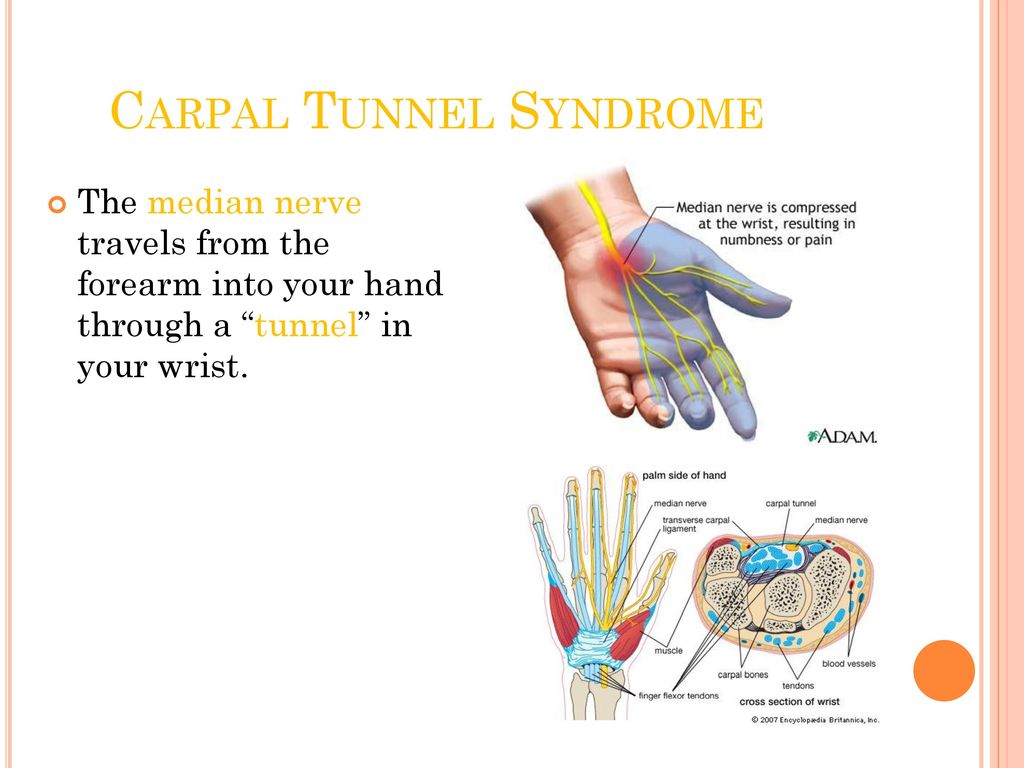 Mild symptoms can often be controlled with simple workflow changes.
Mild symptoms can often be controlled with simple workflow changes.
Friends, Anna Ovsyannikova’s seminar “Hand Rehabilitation after Distal Radius Fracture (Typical Radius Fracture”) and Metacarpal Fractures will take place very soon. Learn more…
Manual therapy methods include mobilization of soft tissues, carpal bones and median nerve. You can also do orthotics.
Other methods may include ultrasound and electromagnetic field therapy.
Study results (varied):
- Physical therapy methods such as transcutaneous electrical stimulation and ultrasound have little effect on sensory deficits.
- Evidence for the effectiveness of exercises and mobilization techniques is limited and of very low quality.
- Data on postoperative rehabilitation are also limited. None of the proposed interventions appears to have an overriding advantage.
Conclusion
Patients can benefit from physiotherapy treatment focused on reducing median nerve symptoms and functional improvement. This is possible if
This is possible if
- Their symptoms are intermittent and do not rapidly increase, or if their CTS etiology suggests the possibility of remission (for example, in the case of pregnancy).
- Patients are informed of the lack of high-quality evidence for the efficacy and safety of the therapeutic methods used by physiotherapists.
Treatment should be discontinued if it is proven to be ineffective and appropriate evidence-based recommendations should be made at discharge.
Median nerve symptoms usually worsen over a long period of time (despite conservative treatment). Surgical interventions have been shown to be safer and more effective than any conservative intervention for eligible patients. Clinicians should be aware that persistent tingling or numbness is due to significant compression of the median nerve. The prolonged existence of such symptoms can lead to irreversible changes in the structure of the nerve, which can adversely affect the effectiveness of the surgical intervention and, thereby, doom such patients to permanent symptoms and thenar muscle atrophy.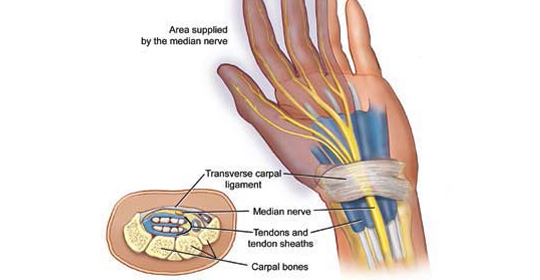


 This particular movement can be seen in occupational pathological conditions.
This particular movement can be seen in occupational pathological conditions. Like the above tests, a positive test is when symptoms are reproduced.
Like the above tests, a positive test is when symptoms are reproduced.
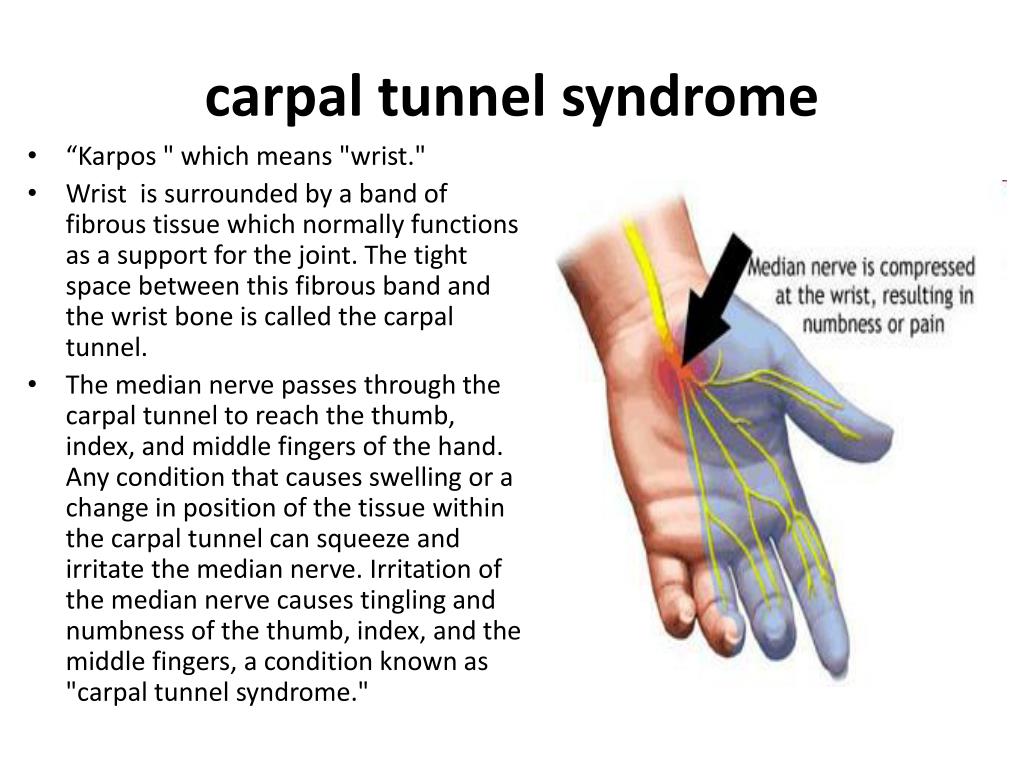
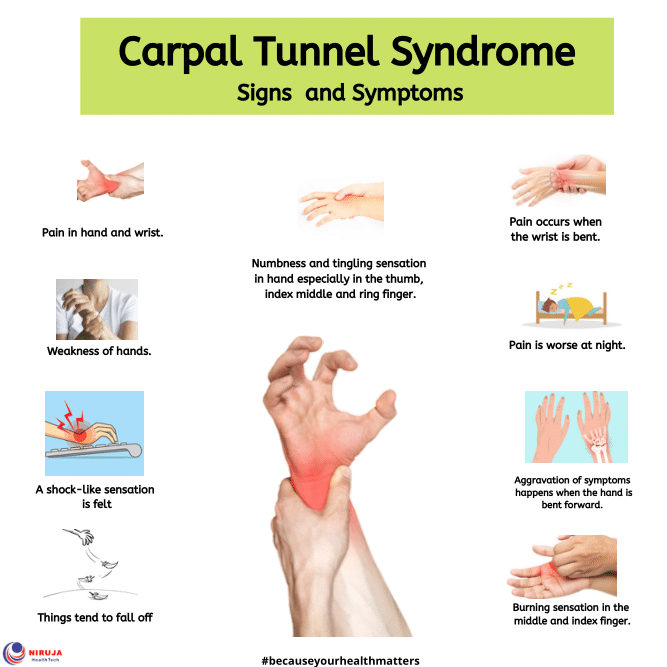 StatPearls [Internet]. StatPearls Publishing; Treasure Island (FL): Sep 4, 2022. Median Nerve Block Techniques. [PubMed: 29083641]
StatPearls [Internet]. StatPearls Publishing; Treasure Island (FL): Sep 4, 2022. Median Nerve Block Techniques. [PubMed: 29083641] 2016 Jun;41(6):665-672.e1. [PMC free article: PMC4899197] [PubMed: 27068003]
2016 Jun;41(6):665-672.e1. [PMC free article: PMC4899197] [PubMed: 27068003]
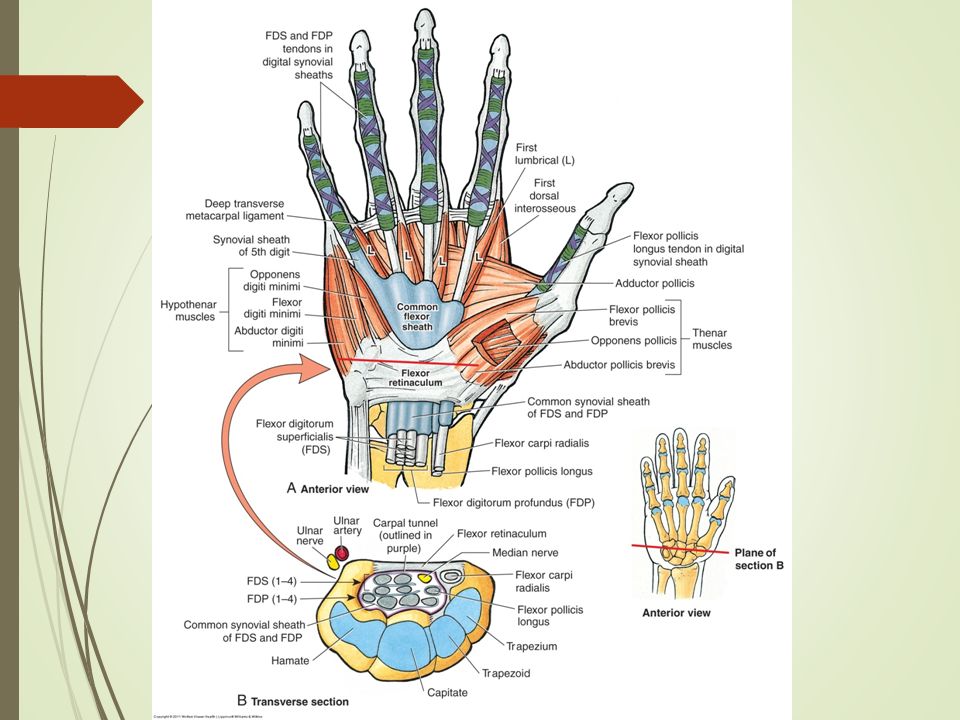




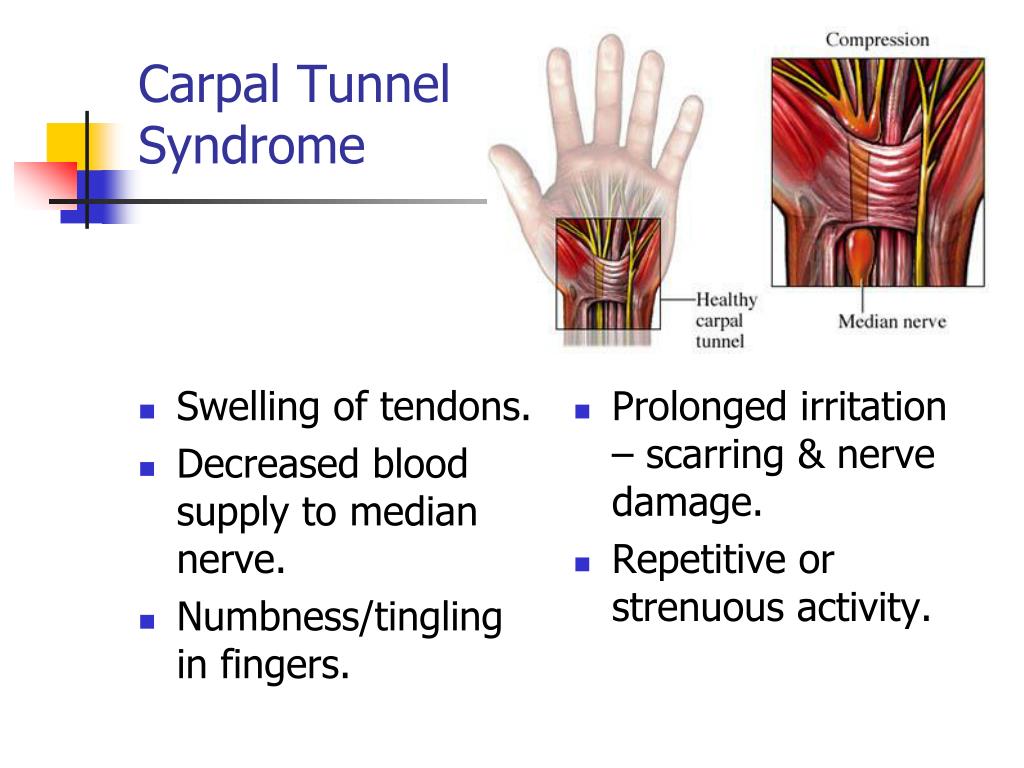 The test is considered positive when symptoms (numbness, tingling, pain) are reproduced.
The test is considered positive when symptoms (numbness, tingling, pain) are reproduced.